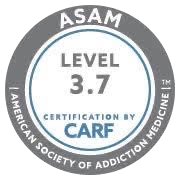Fentanyl has played a devastating role in the opioid epidemic in the United States. If you’ve been impacted by fentanyl, directly or indirectly, you may know how potent it is. There are families across the country who are losing loved ones every day because of fentanyl; in many cases, they didn’t know they were using it.
Fentanyl test strips have become one potential harm reduction method, but the only way to avoid an overdose with complete certainty is to abstain from drugs. There is a role for fentanyl test strips in harm reduction, but with that, there should be efforts aimed at helping more people get treatment for substance abuse and addiction.
Why Is Fentanyl So Deadly?
Every day, there are headlines focused on fentanyl and its effects, so why is it so much more impactful than other opioids at the moment? While fentanyl works like other opioids, including heroin and prescription painkillers, it’s much stronger. It’s as much as 100 times stronger than morphine, so even tiny doses can end up being lethal.
If you’re unaware that you’re even consuming fentanyl, you’re at an exceptionally high risk of overdosing. Fentanyl is frequently added to other substances, like cocaine, heroin, and counterfeit pills, without the knowledge of the user.
Adding fentanyl to other drugs is becoming increasingly common in the illegal drug market because it can mimic the effects of other opioids or make medicines stronger.
Fentanyl is sometimes pressed into counterfeit pills that look like prescription drugs, including Xanax or oxycodone. The pills are then sold on the illegal market and can contain a variable amount of fentanyl.
There are also situations where fentanyl is mixed with other drugs while they’re being manufactured. The residue can contaminate surfaces where other drugs are handled, leading to unintentional exposure.
The uptick in fentanyl-related overdoses in recent years has gone up in part because it’s highly potent and also because it’s increasingly available. Compared to other opioids, it’s cheaper to produce fentanyl as well.
Drug markets, given their illegal nature, make it incredibly hard to determine what’s in substances being consumed.
What Are Fentanyl Test Strips?
Fentanyl test strips are a tool to detect whether fentanyl is present in counterfeit pills, cocaine, heroin, or other drugs sold illegally. The test strips are meant to be a simple, fast way to determine if a drug sample has fentanyl in it. The goal is to help detect even small amounts of fentanyl for more informed decision-making about drug use, potentially preventing an accidental overdose.
How Do Fentanyl Test Strips Work?
Fentanyl test strips work in a way similar to home pregnancy tests and some other rapid diagnostic tests. They’re based on the concept of an immunoassay.
So, what does that mean?
First, if someone’s going to use a fentanyl test strip, they take a small amount of the substance. Then, it’s mixed with a buffer solution, which prepares the sample to be tested.
The sample is then applied to the fentanyl test strip. The test strip has antibodies that bind to fentanyl molecules. If the drug sample has fentanyl, it will bind to the test strip.
After the binding step, a test strip is washed, which removes substances that aren’t bound. The fentanyl molecules, if they’re present, stay attached when the strip is washed.
The test strip then has a reactive indicator, usually made of colloidal gold particles. The fentanyl molecules captured by the primary antibodies on the test strip attach to secondary antibodies, creating a visible signal, usually a line.
If the line or signal appears on a test strip, fentanyl is present. The intensity of the line corresponds with the concentration of fentanyl in the sample.
Are Fentanyl Test Strips Accurate?
While fentanyl test strips are considered reliable tools, as is valid with any diagnostic test, the accuracy can be influenced by several factors.
For example, a fentanyl test strip has a detection threshold, and below that, fentanyl’s presence might not be reliably detected. The strips’ sensitivity can vary depending on the quality of the testing procedure and how concentrated fentanyl is in the sample.
Properly preparing a sample is essential to get an accurate result, so using it improperly or not mixing it correctly can lead to false negatives or false positives.
Another factor affecting accuracy is the interpretation of the results. Users should be trained to interpret test strips and their results, reducing the risk of errors.
While fentanyl test strips can be essential harm-reduction tools, they’re not infallible.
The Benefits of Fentanyl Test Strips
Some benefits come with these test strips, including preventing accidental overdoses. They can save lives and help empower people to make informed decisions surrounding drug use.
The strips encourage safer drug use practices, which is the goal of harm reduction strategies. Other harm reduction practices include encouraging substance use only when with different people and having naloxone on hand. Naloxone is a medicine that reverses opioid overdoses.
They’re relatively inexpensive and easily accessible, encouraging people within the community to be proactive in addressing the opioid overdose crisis.
Test strips are available in various places, including pharmacies and online retailers. Many community-based harm reduction organizations and health centers distribute them to prevent drug overdoses, and specific public health initiatives and community health programs also make them available.
Final Thoughts
The prevalence of
fentanyl contamination in illegal drugs is an ongoing public health challenge that’s reached a crisis point. Fentanyl test strips are one part of a more extensive harm reduction approach, but it’s still essential that we all recognize the importance of comprehensive approaches to substance use disorders. This includes access to evidence-based treatment and support services.
If you or someone you know is struggling with addiction, treatment is essential. At San Diego Detox, we offer compassionate, effective detoxification and treatment services to help individuals begin their recovery.



